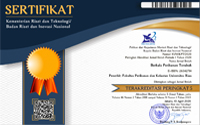ANALISIS MONSUN DI LAUT JAWA
Abstract
Keywords
Full Text:
PDFReferences
Aldrian, E. and R.D. Susanto. 2003. Identification of Three Dominant Rainfall Region Within Indonesia And Their Relationship To Sea Surface Temperature.Int.J.Climatology.23:1435-1452. DOI: 10.1002/joc.950.
Hartoko, A., dan W. Sulistya. 2010. Meteorologi dan Sifat Lautan Indonesia. Pustaka Badan Meteorologi dan Geofisika . ISBN : 978-979-1241-25-0.
Hendiarti. 2005. Seasonal Variation of Coastal Processes and Pelagic Fish Catch Around The Java Island. Journal of Oceanography.18 (4).pp 112-123.
Doi.org/10.5670/oceanog.2005.12.
Lakitan, B. 1994. Dasar-Dasar Klimatologi. PT. Raja Grafindo Persada. Jakarta.
Mulyadi, M.I. Jumarang, dan Apriansyah. 2015. Studi Variabilitas Tinggi dan Periode Gelombang Laut Signifikan di Selat Karimata. Positron, V (1):19-25, DOI: 10.26418/positron.v5i1.9737.
Nagara, GA., N.A. Sasongko, and O.J. Olakunle. 2007. Introduction to Java Sea. University of Stavanger. Norwegia.
Qian, J. H., A. W. Robertson, and V. Moron. 2010. Interactions between ENSO, Monsoon and Diurnal Cycle in Rainfall Variability over Java, Indonesia. Journal of Atmospheric Science,67, 3509-3524. DOI: 10.2174/187428230181201008.
Setyawardhana, H. 2006. Pengaruh ENSO (El Nino Southern Oscillation) Terhadap Sebaran Suhu Permukaan Laut, Klorofil-a, dan Zona Potensi Perikanan di perairan Jawa Bagian Timur, Selat Bali dan Sekitarnya. Journal LAPAN. Bandung.
Sulistya, W. dan A. Hartoko. 2009. Meteorologi dan Sifat Lautan Indonesia. Pusat Penelitian dan pengembangan BMKG. 121 halm. ISBN: 978-979-1241-25-0.
Susilokarti D., S. Arif, S. Susanto, dan L. Sutiarso. 2015. Identifikasi Perubahan Iklim Berdasarkan Data Curah Hujan di Wilayah Selatan Jatiluhur Kabupaten Subang, Jawa Barat. Agritech, 35 (1) : 98-105.
Tjasyono, B. 2004. Klimatologi. Cetakan Ke-2, ITB Press, Bandung.
Tjasyono, B. 2014. Atmosfer Ekuatorial. BMKG Jakarta.
Webster, P.J. and J. Fasullo. 2003. Monsoon / Dynamical Theory. Encyclopedia of Atmospheric Science. Elsevier Science, 1370-1386.
DOI: http://dx.doi.org/10.31258/terubuk.48.2.492-500
Refbacks
- There are currently no refbacks.
Copyright (c) 2020 Yosafat Donni Haryanto, Rezfiko Agdialta, Agus Hartoko

This work is licensed under a Creative Commons Attribution 4.0 International License.












